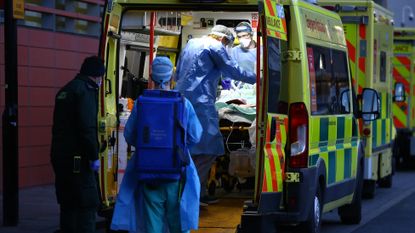Coronavirus: four key facts about the UK’s new year Covid spike
Almost 25,000 people in hospital with the virus as infections continue to climb nationwide

Pressure is growing on Boris Johnson to impose stronger coronavirus restrictions as infection rates climb to record highs across the UK.
With hospitalisations and case numbers now at what Politico London Playbook’s Alex Wickham describes as “frankly terrifying levels”, the prime minister and senior ministers are considering the introduction of a “Tier 5” or a third national lockdown to stem the spread of Covid.
The full extent of the increase in infections resulting from Christmas household mixing is not yet known, but Johnson is “facing considerable pressure from his scientific advisers, Labour and some Conservative MPs to move much more quickly”, Wickham adds. Here is a summary of the current state of play in four key facts.
Subscribe to The Week
Escape your echo chamber. Get the facts behind the news, plus analysis from multiple perspectives.

Sign up for The Week's Free Newsletters
From our morning news briefing to a weekly Good News Newsletter, get the best of The Week delivered directly to your inbox.
From our morning news briefing to a weekly Good News Newsletter, get the best of The Week delivered directly to your inbox.
Record setter
Since Christmas, the UK has repeatedly broken its previous records for the numbers of new cases recorded each day, and government figures show the daily tally has stood at more than 50,000 since 31 December. Deaths within 28 days of a positive test have also risen, peaking at 964 on the final day of 2020.
“No English region is escaping the escalating crisis”, with London and the Southeast hit especially hard, says the Financial Times (FT).
In the capital, “16% of those tested on 22 December received a positive result, a proportion not seen since late April”, the newspaper continues. And data released on Sunday shows that total “has surged to 27%, a level last seen in the middle of the spring wave”.
Sign up for Today's Best Articles in your inbox
A free daily email with the biggest news stories of the day – and the best features from TheWeek.com
Meanwhile, deaths from infections triggered by the relaxation of Covid rules on 25 December have yet to be recorded, due to the lag time between catching and succumbing to the virus.
Sick man of Europe
The UK’s rate of infection is “running not far off four times the case rate of other large European countries - and rising”, according to Conservative MP Neil O’Brien, chair of the party’s Policy Board.
Only Ireland is recording a rise comparable to that in the UK. O’Brien tweets that we “may be seeing the effect of the new, more infectious variant starting to spill over into Ireland, our only land border”.
While Johnson weighs up whether to plunge the UK back into lockdown, other European countries are already taking drastic action. Germany is “likely to extend a national lockdown beyond 10 January to curb coronavirus infection rates”, Reuters reports, and Emmanuel Macron is considering the imposition of a third national lockdown in France.
Hospital overload
Increasing caseloads means increasing pressure on hospitals, with “daily admissions of Covid-19 patients now above the spring peak in the southeast, southwest and east of England”, the FT reports.
London is also “on the brink” of passing that mark, the paper adds, and “Covid patients now occupy more than half of all available beds in adult wards in several hospitals in the South”.
“There are now almost 25,000 people with Covid-19 in English hospitals - 32% more than the April peak,” Christina Pagel, director of the Clinical Operational Research Unit at University College London, tweeted yesterday.
Underlining the extent of the crisis, NHS Providers CEO Chris Hopson tweeted that government data showed an 8% daily increase in beds occupied by Covid patients in the Northwest and London yesterday, while the Southwest saw a 7% rise.
Grim figures
As overloaded hospitals struggle to provide care for an ever increasing number of Covid patients, government scientists are “now talking privately about the UK’s overall Covid death toll passing the 100,000 threshold around the end of this month”, according to Politico’s Wickham.
The death toll currently stands at just over 75,000 - meaning the UK faces “a horrendous rise in a short space of time”, he adds. “Speak to anyone in Whitehall and they keep saying this is going to be an extremely tough few weeks.”
Create an account with the same email registered to your subscription to unlock access.
Joe Evans is the world news editor at TheWeek.co.uk. He joined the team in 2019 and held roles including deputy news editor and acting news editor before moving into his current position in early 2021. He is a regular panellist on The Week Unwrapped podcast, discussing politics and foreign affairs.
Before joining The Week, he worked as a freelance journalist covering the UK and Ireland for German newspapers and magazines. A series of features on Brexit and the Irish border got him nominated for the Hostwriter Prize in 2019. Prior to settling down in London, he lived and worked in Cambodia, where he ran communications for a non-governmental organisation and worked as a journalist covering Southeast Asia. He has a master’s degree in journalism from City, University of London, and before that studied English Literature at the University of Manchester.
-
 Nigeria's worsening rate of maternal mortality
Nigeria's worsening rate of maternal mortalityUnder the radar Economic crisis is making hospitals unaffordable, with women increasingly not receiving the care they need
By Harriet Marsden, The Week UK Published
-
 'Elevating Earth Day into a national holiday is not radical — it's practical'
'Elevating Earth Day into a national holiday is not radical — it's practical'Instant Opinion Opinion, comment and editorials of the day
By Harold Maass, The Week US Published
-
 UAW scores historic win in South at VW plant
UAW scores historic win in South at VW plantSpeed Read Volkswagen workers in Tennessee have voted to join the United Auto Workers union
By Peter Weber, The Week US Published
-
 Covid four years on: have we got over the pandemic?
Covid four years on: have we got over the pandemic?Today's Big Question Brits suffering from both lockdown nostalgia and collective trauma that refuses to go away
By Chas Newkey-Burden, The Week UK Published
-
 The hollow classroom
The hollow classroomOpinion Remote school let kids down. It will take much more than extra tutoring for kids to recover.
By Mark Gimein Published
-
 Excess screen time is making children only see what is in front of them
Excess screen time is making children only see what is in front of themUnder the radar The future is looking blurry. And very nearsighted.
By Devika Rao, The Week US Published
-
 Covid-19: what to know about UK's new Juno and Pirola variants
Covid-19: what to know about UK's new Juno and Pirola variantsin depth Rapidly spreading new JN.1 strain is 'yet another reminder that the pandemic is far from over'
By Arion McNicoll, The Week UK Published
-
 Long-term respiratory illness is here to stay
Long-term respiratory illness is here to stayThe Explainer Covid is not the only disease with a long version
By Devika Rao, The Week US Published
-
 Covid inquiry: the most important questions for Boris Johnson
Covid inquiry: the most important questions for Boris JohnsonTalking Point Former PM has faced weeks of heavy criticism from former colleagues at the public hearing
By The Week Staff Published
-
 China's pneumonia cases: should we be worried?
China's pneumonia cases: should we be worried?The Explainer Experts warn against pushing 'pandemic panic button' following outbreak of respiratory illness
By Keumars Afifi-Sabet, The Week UK Published
-
 Vallance diaries: Boris Johnson 'bamboozled' by Covid science
Vallance diaries: Boris Johnson 'bamboozled' by Covid scienceSpeed Read Then PM struggled to get his head around key terms and stats, chief scientific advisor claims
By The Week UK Published